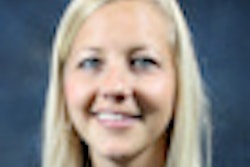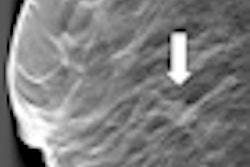
In 2009, the U.S. Preventive Services Task Force (USPSTF) issued updated mammography guidelines, recommending that women start receiving regular biennial mammograms after the age of 50, instead of annual mammograms beginning at 40. The USPSTF's position sparked a firestorm of debate over the benefits and harms of the technology that has continued until today.
But this debate is only the latest iteration of controversy over mammography's value as a breast cancer screening tool, according to Dr. Handel Reynolds, a breast radiologist at the Doris Shaheen Breast Health Center at Piedmont Hospital in Atlanta. Reynolds has written a book that examines the use of mammography since its introduction in the 1970s and links it to social and political movements.
The following is an excerpt from Reynold's book, titled The Big Squeeze: A Social and Political History of the Controversial Mammogram (Cornell University Press, 2012). In this section -- "Preaching the Gospel of Early Detection" -- Reynolds explains how the idea arose that early detection of breast cancer could save women's lives, as well as how it has affected the use of mammography as a screening tool.
 Dr. Handel Reynolds from Piedmont Hospital in Atlanta.
Dr. Handel Reynolds from Piedmont Hospital in Atlanta.
For most of the 20th century, the principal theme of public discourse on breast cancer was early detection. This arose from the prevailing medical view of cancer as, initially, a local disease that, if treated early and aggressively, could be cured. As early as 1894, William Halsted, the renowned Johns Hopkins University surgeon who pioneered the radical mastectomy, wrote that "cancer of the breast is a curable disease if operated upon properly and in time." Whether by design or happenstance, Halsted's phrase "operated upon properly and in time" encapsulated the essence of the cancer education programs that would come to dominate the new century. The point was simply that surgery cures cancer, but only if the patient presents to the surgeon promptly. A May 1913 Ladies' Home Journal article titled "What Can We Do about Cancer?" put it bluntly: "No cancer is hopeless when discovered early. Most cancer, discovered early, is curable. The only cure is the knife. Medicines are worse than useless. Delay is more than dangerous; it is deadly. The one hope, and a strong one, is prompt and radical operation; a half operation is worse than none at all."
Founded in 1913 by a group of surgeons, the American Society for the Control of Cancer (ASCC) was warmly received and fully endorsed by the larger medical establishment. From its inception, the dominant message of the ASCC was that surgeons could effectively treat (and cure) cancer in its earliest stages. Early on, cancers specific to women received particular attention. To reach the female public more effectively, the male-dominated ASCC established an all-female wing, the Women's Field Army, in 1937. This organization, modeled after a military unit down to the military-style uniforms and insignia its members wore, became known as the "educational arm of the ASCC." At its peak, the Women's Field Army had 700,000 members, each having paid a one-time enrollment fee of $1. These large funds were used to finance a massive public education campaign consisting of mass meetings, lectures, radio broadcasts, and newspaper and magazine articles, as well as educational brochures. Women were the target audience, and the focus was breast and reproductive cancers. The overall message was threefold: that cancer could be cured, that early detection allowed successful treatment, and that regular medical checkups for women, even when they were feeling well, were essential.
In 1944 the ASCC underwent a major restructuring incited by a prominent New York philanthropist and healthcare activist, Mary Lasker. In addition to a change in the governance of the organization, the ASCC was rebranded the American Cancer Society (ACS). Shortly thereafter the Women's Field Army was integrated into the ACS and the organization adopted a new focus: securing funds for cancer research through charitable donations. Its initial fundraising activities were wildly successful, and within its first year of existence the ACS became the largest nongovernmental funding agency for cancer research.
Promoting early detection, however, remained a major focus of the ACS. In 1948 it produced "Life Saving Fingers," the first educational film on breast self-examination (BSE). In it, a woman, undressed from the waist up, demonstrated the procedure. The film was narrated by Dr. Alfred Popma, a Boise, ID, radiologist who is credited with developing the first educational materials specifically describing the proper technique for BSE. It was widely distributed and shown to packed houses in major cinemas.
In addition to films, the postwar period saw continued dissemination of the early detection message in articles and advertisements in the popular press, posters, and educational pamphlets. As noted by the historian Kirsten Gardner, many of these directly targeted women and used fictional characters who demonstrated "good/wise" or "bad/foolish" behavior by following or not following ACS recommendations for early detection. A "wise" woman was one who noted a lump in her breast and quickly sought treatment. She was portrayed as happy and healthy. A "foolish" woman ignored her lump, not seeking care until it was too late. She was portrayed as depressed and dying. Thus, observes Gardner, "women's behavior became the key variable in cancer control. ... [I]f a woman with cancer failed to follow early detection principles, death seemed inevitable, and the victim assumed the blame." There was little to no discussion of the difficulty and uncertainty inherent in examining breasts (limitations of early detection), the physical impact of radical mastectomy (the only treatment available at the time), or the possibility that death may still occur despite "wise" behavior (treatment failure). While this single-minded focus on early detection may have been well-intentioned, calculated to empower women and replace fear with hope, it had unintended consequences, some of which still echo faintly today in the guilt many women experience when a cancerous lump is found by their doctor or on a mammogram -- guilt for having "failed" at BSE by not finding it first.
At this point it is helpful to digress briefly and consider another important female reproductive cancer. The American Cancer Society's efforts against cervical cancer would come to define its approach to screening mammography some decades later.
In January 1928, George Papanicolaou, a Greek-born pathologist who had emigrated to the United States in 1913, presented some preliminary observations at the Third Race Betterment Conference in Battle Creek, MI. Papanicolaou, working at Cornell Medical College, had obtained daily vaginal smears from a group of women and examined them microscopically for cellular aberrations. He showed that malignant cells and precancerous lesions could be detected with this simple technique. Papanicolaou's work aroused very little interest in the medical community for many years. Surgical orthodoxy at the time accepted open biopsy as the only reliable means of diagnosing cervical cancer. In the 1930s and 1940s, Papanicolaou's findings were reproduced by other researchers, yet there was limited adoption of the new technique. Major barriers to adopting the Pap test were lack of education among physicians and the lay public, as well as absence of an infrastructure of professional cytotechnicians and pathologists trained in the technique.
With these considerations in mind, an ambitious five-year cervical cancer screening program was launched in 1952. Dubbed the Memphis Project, it was jointly sponsored by the Cancer Control Branch of the National Cancer Institute (NCI), the University of Tennessee, and the Memphis branch of the ACS. The goal of the project was to screen all 165,000 women over the age of 20 in the Memphis-Shelby County, TN, area annually for five years. The ACS and its army of volunteers played an important role in the public education component of the project. During the course of the study, over 150,000 women were screened, and a large number of early-stage cervical cancers were diagnosed. Prior to the initiation of screening, 34% of white and 18% of African-American cervical cancer patients in the Memphis-Shelby County area were diagnosed in stage 1. During the program, these rates increased to 57% and 38%, respectively.
The success of the Memphis Project showed that the Pap smear could be efficiently applied to large populations, that early detection of cervical cancer was possible, and thus lives could be saved. In 1953 the U.S. death rate from uterine cancer (including cancer of the cervix as well as the body of the uterus) was 16.8 per 100,000 women. By 1963 the death rate had been reduced by a remarkable 27%, to 12.2 per 100,000. This notable achievement was largely due to widespread adoption of the Pap smear in routine gynecologic care. The Pap smear represents the most dramatic validation of early detection in the history of medicine. These efforts were viewed as unmitigated triumphs of the principles long espoused by the ACS. The elixir of success strengthened its resolve and bolstered its confidence.
Thus, by the time screening mammography was introduced to the public in the early 1970s, the notion of early detection for effective cancer control had been successfully inculcated in the American psyche. The new screening test promised to be more reliable than the patient's fingers and would lighten the burden that self-examination placed upon her. The ACS, hoping to reproduce its success against cervical cancer, would again play a leading role in the dissemination of a new screening technology. Add to this the new cancer-fighting political agenda in Washington, DC, and the growing women's healthcare activism, and the stage was set for screening mammography to have a successful opening act.
© 2012 Cornell University




















